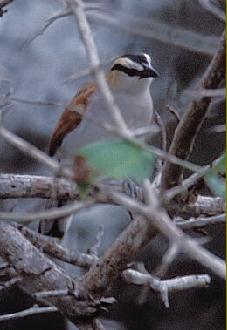|
Tchagra |

|
|
Scientific classification |
| Kingdom: |
Animalia
|
| Phylum: |
Chordata
|
| Class: |
Aves
|
| Order: |
Passeriformes
|
| Family: |
Malaconotidae
|
| Genus: |
Tchagra
Lesson, 1830 |
|
| species |
T. minuta
T. senegala
T. australis
T. jamesi
T. tchagra |
The Tchagras are
passerine
birds in the
bushshrike family, which are closely related to the true
shrikes in the family Laniidae, and were once included
in that group. These five species form the genus
Tchagra within the bushshrike family:
- Marsh Tchagra, Tchagra minuta
Black-crowned Tchagra, Tchagra senegala
Brown-crowned Tchagra or Brown-headed Tchagra, Tchagra
australis
Three-streaked Tchagra, Tchagra jamesi
Southern Tchagra, Tchagra tchagra
The Marsh Tchagra is sometimes placed in the monotypic
genus Antichromus, and then named as Blackcap
Bushshrike. The dark Angolan subspecies of Marsh Tchagra was
formerly sometimes split as Anchieta's Tchagra, Tchagra
anchietae, named after Portuguese explorer José Alberto de
Oliveira Anchieta by his zoologist compatriot José Vicente
Barbosa du Bocage in 1869.
These are long-tailed birds, typically with a grey or
grey-brown back, brown wings and grey and whitish underparts.
The head pattern is distinctive, with a dark cap and black
eyestripe separated by a white
supercilium. The bill is strong and hooked.
The male and female are similar in plumage in all tchagra
species, but distinguishable from immature birds.
These are solitary birds which tend to skulk low down or
on the ground. They have distinctive whistled calls and can
be readily tempted into sight by imitating the call,
presumably because the tchagra is concerned that there is an
intruder in its territory.
These are species typically of scrub, open woodland,
semi-desert and cultivation in sub-Saharan Africa. They hunt
large insects from a low perch in a bush, and the larger
species like Black-crowned Tchagra will also take vertebrate
prey such as frogs and snakes.
References
- Barlow, Wacher and Disley, Birds of The Gambia
ISBN 1-873403-32-1
- Tony Harris and Kim Franklin, Shrikes and
Bush-Shrikes
ISBN 0-7136-3861-3




